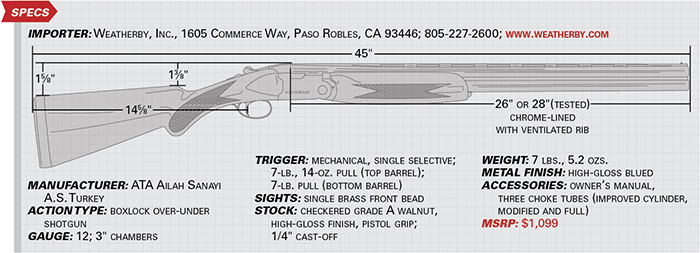
Orion the Hunter is one of the most recognized constellations in the night sky, and for Weatherby, a recognizable new re-addition to its line of shotguns. Like others, Weatherby, the long-time rifle company that specializes in high-velocity magnum calibers, has turned to Turkey for this budget-priced over-under.

A well-thought-out, entry-level over-under, the Orion is loaded with features. Primary among them is the manual safety. This style of safety requires that the shooter apply the safety by sliding it back into the on-safe position each time the gun is fired. Because selection of one barrel or the other carrying a different choke constriction is a major feature of double guns, the barrel selector is carried in the safety slide. When a barrel is to be selected, the safety must be fully retracted to the on-safe position. The barrels are identified by a small single dot for the lower barrel and two dots for the upper barrel.
The trigger is mechanical, which means that regardless of whether or not the first barrel fires, the second will; recoil is not required for the gun to set the sear for the second shot. We prefer this arrangement for a hunting gun, as often shots are few and far between, and if for any reason the first barrel fails to fire, the second can be brought into action.

Another outstanding feature is the automatic ejectors. In use, they eject the fired hulls with gusto, or lift unfired shells from the chamber mouth to enable easy removal, even with a gloved hand.
From the butt forward, the recoil pad is of soft material that will help soak up the kick present in any fixed-breech shotgun. The stock itself is select, but straight-grained walnut set off with a high-gloss finish. The Prince of Wales grip is comfortable and well-suited to a variety of hand sizes and is checkered for a firm hold. The fore-end of the test gun is of similar walnut and matched in color and grain to that of the buttstock. It is also checkered in a large, traditional pattern. Especially useful is the Anson-style fore-end release rod. Rather than the more common Deeley & Edge-style fore-end latch, this type enables the user to press in on the tip of the rod and pull down, making removal of the fore-end easy.
 The action is typical of Italian over-unders, with the barrels rotating on trunnions mounted on the side of the action. The monobloc barrels have matching cutouts that mate with the trunnions, making for a slender, low-profile action, and ensuring a long service life. The barrels lock to the action by means of two truncated, cone-shaped bolts that project from the face of the breech and engage mating cuts in the barrels about three-quarters of the way down the top-barrel’s chamber. This locking system is in wide use and should last for years of shooting.
The action is typical of Italian over-unders, with the barrels rotating on trunnions mounted on the side of the action. The monobloc barrels have matching cutouts that mate with the trunnions, making for a slender, low-profile action, and ensuring a long service life. The barrels lock to the action by means of two truncated, cone-shaped bolts that project from the face of the breech and engage mating cuts in the barrels about three-quarters of the way down the top-barrel’s chamber. This locking system is in wide use and should last for years of shooting.
The barrels themselves also match the action’s high-gloss blue finish, and are internally chrome-plated. Chrome plating serves as both a barrier to rust and corrosion, and increases lubricity, making cleaning quick and easy. The chambers are cut to exactly 3" on our Galazan chamber gauge. The barrel diameters measured 0.723" for the bottom barrel and 0.723" for the top, each just a shade tighter than the common dimension of 0.725". Three screw-in, Beretta-style choke tubes are supplied identified by a series of notches. Company literature advertises these to measure improved cylinder, modified and full choke, but those provided with our sample gun measured a bit more open than advertised. The four-notch tube measured true cylinder with no constriction. The three-notch provided 0.009" of constriction, just a touch less than improved cylinder, and the one-notch tube came in at 0.027", nearly full choke dimension. We did notice what appeared to be either solder-flux bloom or bluing-salt stain on both sides of the barrel ribs where they join the top and bottom barrels. Caught quickly, it’s a simple matter to scrub it away with an old toothbrush and some oil.
We took the Orion to the range for some shooting and the results of the patterning are tabulated nearby. We used Rio TLT2475 ammunition, with 7/8 oz. of No. 7½ shot, which is a very versatile load for upland game and clays. The average velocity, chronographed at 3 ft., was 1361 f.p.s., a touch faster than the box states as 1340 f.p.s. No matter, as this is a soft-recoiling load good for beginners and experienced shots alike for anything from game-farm pheasants to quail, dove, grouse, rabbits, etc. Pattern percentages with the rather open four-and three-notch tubes were fairly diffuse, and more pertinent to shooting at 30 yds. and less; tighter chokes are a problem easily solved by aftermarket purchase of tighter tubes from a source such as Trulock Chokes. Work on skeet targets on a steamy July day was more than satisfactory, as the slight barrel-forward balance kept the swing moving with the bird.
In all, the Weatherby Orion is a good entry-level shotgun with a modest price. It functioned well, and felt equally good, which is the mark of an excellent shotgun.








































